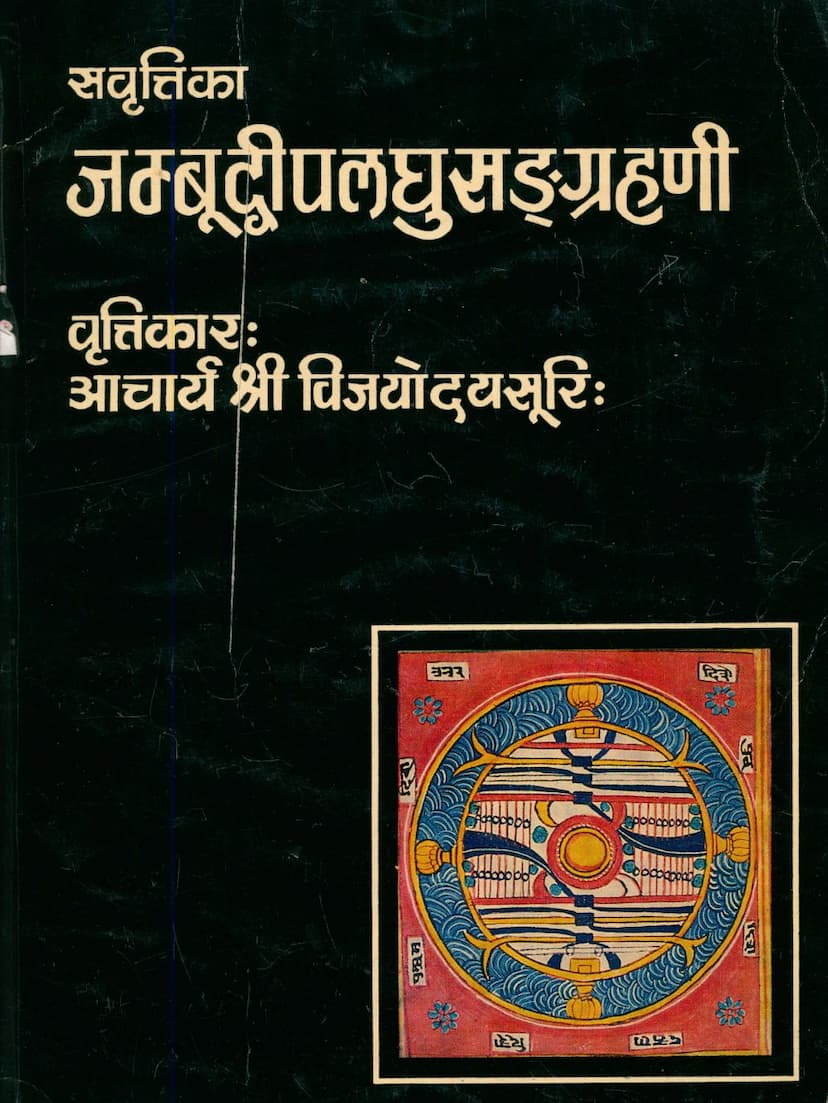Jambudwip Laghu Sangrahani
Added to library: September 2, 2025

Summary
Here is a comprehensive summary of the Jain text "Jambudwip Laghu Sangrahani" by Vijayodaysuri, based on the provided pages:
Title: Jambudwip Laghu Sangrahani (A Concise Compendium of Jambudvipa) Author/Commentator: Acharya Shri Vijayodaysuri (his commentary is included) Original Author: Acharya Shri Haribhadrasuri (credited with the main text) Publisher: Shri Jain Granth Prakashan Samiti, Khambhat Year of Publication: Vikram Samvat 2045 (1988 CE) Edition: First Edition
Overall Purpose and Content:
This text is a commentary by Acharya Vijayodaysuri on the "Jambudwip Laghu Sangrahani" by Acharya Haribhadrasuri. The original text itself is a concise exposition of Jambudvipa, a central continent in Jain cosmology, detailing its geography, dimensions, constituent parts, and associated phenomena. Acharya Vijayodaysuri's commentary aims to elucidate this complex subject matter, making it accessible to a wider audience.
Key Themes and Structure:
-
Jain Cosmology and Geography: The core of the work is the detailed description of Jambudvipa, one of the primary continents in the Jain universe. It outlines the structure of the cosmos into three parts: Urdhva Loka (Upper World), Madhyaloka (Middle World), and Adhaloka (Lower World). Jambudvipa is situated in the Madhyaloka.
-
Jambudvipa's Dimensions and Layout:
- Jambudvipa is described as a circular continent with a diameter of 100,000 yojanas (an ancient unit of measurement).
- At its center lies the Mount Meru, a colossal mountain of immense height (100,000 yojanas).
- The continent is divided into seven regions or kshetras: Bharat, Haiimavat, Hari, Mahavideha, Ramyak, Hairanyavat, and Airavat.
- These regions are separated by significant mountain ranges (like Himavan, Mahahimavan, Nishadha, Shikhari, Rukmi, and Nilavan).
- The text details the north-south and east-west dimensions of each kshatra and the mountains, often following a pattern of doubling or halving.
- The central Mahavideha kshatra is particularly important, containing Mount Meru and the Devakuru and Uttarkuru regions.
-
Key Features and Elements:
- Mountains: Detailed descriptions of various mountain ranges, including the circular Vaitadhya mountains and the longitudinal Vaitadhya ranges, along with their heights, materials, and associated deities or regions.
- Rivers: The text enumerates major rivers like Ganga, Sindhu, Rakta, Raktavati, Sita, Sitoda, etc., tracing their origins from mountain lakes and their courses across the kshetras. Their widths and flow are also described.
- Cities and Sacred Sites (Tirthas): Mentions of important cities like Ayodhya and sacred sites associated with rivers.
- Jambudvipa Trees: The presence of the mythical Jambudvipa tree at the center is significant, giving the continent its name.
- Time Cycles (Yugas/Aras): The text discusses the concept of Utsarpini (ascending time cycle) and Avasarpini (descending time cycle), each divided into six Aras (stages). It explains how various aspects like lifespan, physical stature, and moral disposition of beings change across these cycles. The current era is described as being in the Avasarpini cycle.
- Deities and Celestial Beings: Mentions of various classes of celestial beings (Devas) residing in different parts of Jambudvipa and their associated abodes.
- Mathematical and Astronomical Concepts: The text delves into calculations for Jambudvipa's circumference and area, using mathematical principles that differ from modern geometry, notably the use of √10 for Pi (π). It discusses different values attributed to Pi in Jain traditions and compares them with modern scientific understanding.
- Chronology and Ages: The description of the changing lifespans and physical characteristics across the Aras provides a framework for understanding the duration and evolution of beings within the Jain temporal framework.
-
Commentary's Contribution (Acharya Vijayodaysuri):
- The publication of this text is particularly significant as it includes the previously unpublished Sanskrit commentary by Acharya Vijayodaysuri.
- The commentator was a respected scholar and the disciple of Acharya Vijayasuryodayasuri.
- The commentary aims to clarify the intricate details and potentially complex calculations presented in Haribhadrasuri's original work.
- The Prakashiya Nivedan (Publisher's Statement) highlights the rarity of this commentary and its release coinciding with the birth centenary of Acharya Vijayodaysuri. It also expresses gratitude to those who supported the publication.
-
Introduction (Prastavana): The introductory section by the editor, Muni Nandighoshvijay, draws parallels between scientific inquiry and Jain spiritual quests. It emphasizes the human desire for knowledge and the two paths to understanding the universe: spirituality (Adhyatma) and physical science. It acknowledges the differences between ancient Jain descriptions and modern scientific findings, urging for a study of these ancient texts. It also touches upon the historical context of Jain scriptural transmission, mentioning the challenges faced in preserving the complete knowledge over time.
-
Detailed Structure (Table of Contents): The comprehensive table of contents reveals the depth of coverage, including sections on:
- Mangalam (Auspicious beginning)
- Dasha Dwar Nirupan (Explanation of Ten Gates/Sections)
- Bharat Praman (Dimensions of Bharat)
- Mountains and Regions (Himavatadi)
- Circumference and Area Calculations (Paridhi Ganitapad)
- Descriptions of various regions, mountains, rivers, lakes, jewels, etc.
- Detailed explanations of specific features like Meru Parvat, Vajrakuta, Tirthas, Vidyadhara cities, etc.
- Appendices covering various aspects, including "Squaring the Circle" and lists of texts and authors.
Significance:
- Preservation of Knowledge: The text is valuable for preserving and making accessible ancient Jain cosmological and geographical knowledge.
- Scholarly Work: It represents a significant contribution to Jain literature through Acharya Vijayodaysuri's detailed commentary, making a complex topic more understandable.
- Interdisciplinary Interest: The text touches upon mathematics, astronomy, and cosmology, potentially offering insights into ancient Indian scientific thought. The inclusion of discussions comparing Jain cosmology with modern science is also notable.
- Biographical Insight: The preface and introductory articles provide information about the lineage of Jain Acharyas and the scholars involved in this publication, highlighting their dedication and contributions.
In essence, the "Jambudwip Laghu Sangrahani" with Acharya Vijayodaysuri's commentary is a foundational text for understanding the Jain cosmological framework of Jambudvipa, offering a rich tapestry of geographical, mathematical, and temporal descriptions rooted in ancient Jain tradition.